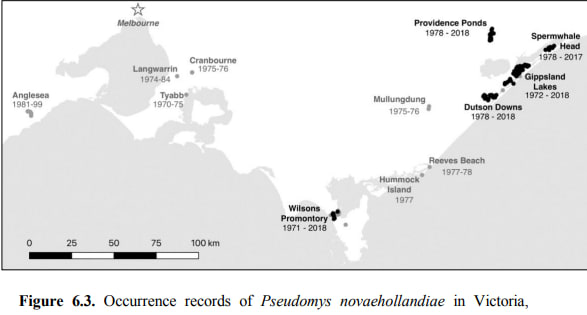The Pookila (formally known as the New Holland Mice, Pseudomys novaehollandiae) is a native species of rodent found within the southeast of Australia and is considered vulnerable[1]. It has been known to occupy corridors of land from the south of the Gold Coast through to the border of Victoria along the Murray River near Albury. The Pookila occupies 5 of 12 known habitats in Victoria[2]. It is found in Tasmania on Flinders Island and has small, isolated populations along the North and Northeast coast[3].
Due to its nature, abundance measures and sampling have been more difficult in the past. However, with the advancement of technology, such as game cameras, researchers are now better than ever able to monitor and discover the existence of the Pookila in the wild.

New Holland Mouse (Pseudomys novaehollandiae)
The Pookila is also under increased pressure from habitat loss, disturbance and modification[4]. Two of its previous known habitats were in the Melbourne suburbs of Cranbourne and Langwarrin[5]. Urban encroachment is part of the habitat loss issue; degradation caused by weed invasion and the reduction in native vegetation caused by Phytophthera (a fungus-like microorganism that damages plants) are also key threats[6][7]. To further complicate the habitat issue, inappropriate fire regimes are also considered a key threat[8][9], as well as competition from other rodents and predation from cats and foxes[10][11].
The Gippsland Lakes Coastal Park contains the largest and most stable population of Pookila in Victoria[12]. The population dynamics appear similar in the Sperm Whale Head / The Lakes National Park due to high habitat suitability[13]. This is despite the Pookila sharing this habitat with Sambar (Rusa Unicolour) and the threatened Hog Deer[14] (Axis Porcinus). Wild deer are understood to have been in these regions for over 100 years, suggesting an ability to live together rather well.
Consequently, priority actions to help Pookila include cat and fox control, implementation of appropriate fire control measures and limiting the spread of Phytophthora are called for[15].
However, like many natives, Pookila is suspectable to Pindone and 1080 oat and carrot poison-baiting[16]. The widespread use of such poisons in the past on the Yanakie Isthmus may have contributed to its decline in Wilsons Promontory, further exacerbated by a change in habitat caused by the encroachment of the Coast Tea Tree[17]. This is why the exclusion of such baits should be a conservation priority[18].
This is a good example of the nuance required to understand the key threatening processes to a particular plant or animal and then take a measured approach to implement and measure effective change to deliver the desired results.
Whilst deer may be an introduced species, a demonstrated ability to coexist with the Pookila should not be ignored, especially at the expense of not addressing existing key threatening processes.
[1] https://www.dcceew.gov.au/environment/biodiversity/threatened/action-plan/priority-mammals/new-holland-mouse
[2] Testing the decline of the threatened New Holland Mouse (Pseudomys novaehollandiae) p I Phoebe Burns 2019
[3] https://www.threatenedspecieslink.tas.gov.au/Pages/New-Holland-Mouse.aspx
[4] https://www.dcceew.gov.au/environment/biodiversity/threatened/action-plan/priority-mammals/new-holland-mouse
[5] https://nativemouse.com/2015/07/29/new-holland-mice-on-camera/
[6] https://www.dcceew.gov.au/environment/biodiversity/threatened/action-plan/priority-mammals/new-holland-mouse
[7] https://www.environment.nsw.gov.au/threatenedspeciesapp/profile.aspx?id=20253
[8] https://www.dcceew.gov.au/environment/biodiversity/threatened/action-plan/priority-mammals/new-holland-mouse
[9] https://www.environment.nsw.gov.au/threatenedspeciesapp/profile.aspx?id=20253
[10] https://www.dcceew.gov.au/environment/biodiversity/threatened/action-plan/priority-mammals/new-holland-mouse
[11] https://www.environment.nsw.gov.au/threatenedspeciesapp/profile.aspx?id=20253
[12] Testing the decline of the threatened New Holland Mouse (Pseudomys novaehollandiae) p 155 Phoebe Burns 2019
[13] Testing the decline of the threatened New Holland Mouse (Pseudomys novaehollandiae) p 155 Phoebe Burns 2019
[14] https://www.iucnredlist.org/species/41784/22157664
[15] https://www.dcceew.gov.au/environment/biodiversity/threatened/action-plan/priority-mammals/new-holland-mouse
[16] Testing the decline of the threatened New Holland Mouse (Pseudomys novaehollandiae) p 159 Phoebe Burns 2019
[17] Testing the decline of the threatened New Holland Mouse (Pseudomys novaehollandiae) p 159 Phoebe Burns 2019
[18] Testing the decline of the threatened New Holland Mouse (Pseudomys novaehollandiae) p 161 Phoebe Burns 2019